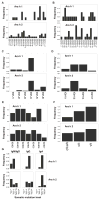Single B-cell deconvolution of peanut-specific antibody responses in allergic patients
- PMID: 26152318
- PMCID: PMC4699867
- DOI: 10.1016/j.jaci.2015.05.029
Single B-cell deconvolution of peanut-specific antibody responses in allergic patients
Abstract
Background: The frequencies, cellular phenotypes, epitope specificity, and clonal diversity of allergen-specific B cells in patients with food allergy are not fully understood but are of major pathogenic and therapeutic significance.
Objective: We sought to characterize peanut allergen-specific B-cell populations and the sequences and binding activities of their antibodies before and during immunotherapy.
Methods: B cells binding fluorescently labeled Ara h 1 or Ara h 2 were phenotyped and isolated by means of flow cytometric sorting from 18 patients at baseline and 13 patients during therapy. Fifty-seven mAbs derived from allergen-binding single B cells were evaluated by using ELISA, Western blotting, and peptide epitope mapping. Deep sequencing of the B-cell repertoires identified additional members of the allergen-specific B-cell clones.
Results: Median allergen-binding B-cell frequencies were 0.0097% (Ara h 1) or 0.029% (Ara h 2) of B cells in baseline blood from allergic patients and approximately 3-fold higher during immunotherapy. Five of 57 allergen-specific cells belonged to clones containing IgE-expressing members. Almost all allergen-specific antibodies were mutated, and binding to both conformational and linear allergen epitopes was detected. Increasing somatic mutation of IgG4 members of a clone was seen in immunotherapy, whereas IgE mutation levels in the clone did not increase.
Conclusion: Most peanut allergen-binding B cells isolated by means of antigen-specific flow sorting express mutated and isotype-switched antibodies. Immunotherapy increases their frequency in the blood, and even narrowly defined allergen epitopes are recognized by numerous distinct B-cell clones in a patient. The results also suggest that oral immunotherapy can stimulate somatic mutation of allergen-specific IgG4.
Keywords: B cell; IgE; IgG(4); Peanut; allergen specific; allergy; antibody; antigen specific; high-throughput DNA sequencing; immunotherapy; repertoire; somatic mutation.
Copyright © 2015 American Academy of Allergy, Asthma & Immunology. Published by Elsevier Inc. All rights reserved.
Figures





Similar articles
-
Peanut oral immunotherapy transiently expands circulating Ara h 2-specific B cells with a homologous repertoire in unrelated subjects.J Allergy Clin Immunol. 2015 Jul;136(1):125-134.e12. doi: 10.1016/j.jaci.2015.03.026. Epub 2015 May 16. J Allergy Clin Immunol. 2015. PMID: 25985925 Free PMC article.
-
Monitoring Ara h 1, 2 and 3-sIgE and sIgG4 antibodies in peanut allergic children receiving oral rush immunotherapy.Pediatr Allergy Immunol. 2014 Jun;25(4):323-8. doi: 10.1111/pai.12243. Pediatr Allergy Immunol. 2014. PMID: 24953293 Clinical Trial.
-
Analysis of cytokine production by peanut-reactive T cells identifies residual Th2 effectors in highly allergic children who received peanut oral immunotherapy.Clin Exp Allergy. 2015 Jul;45(7):1201-13. doi: 10.1111/cea.12537. Clin Exp Allergy. 2015. PMID: 25823600 Free PMC article.
-
[Progress of researches on the allergens Ara h 1, Ara h 2 and Ara h 3 from peanut].Sheng Wu Yi Xue Gong Cheng Xue Za Zhi. 2010 Dec;27(6):1401-5. Sheng Wu Yi Xue Gong Cheng Xue Za Zhi. 2010. PMID: 21375004 Review. Chinese.
-
Developing therapies for peanut allergy.Int Arch Allergy Immunol. 2014;165(3):179-94. doi: 10.1159/000369340. Epub 2014 Dec 20. Int Arch Allergy Immunol. 2014. PMID: 25531161 Free PMC article. Review.
Cited by
-
Regulation of IgE by T follicular helper cells.J Leukoc Biol. 2020 Mar;107(3):409-418. doi: 10.1002/JLB.3RI1219-425R. Epub 2020 Jan 22. J Leukoc Biol. 2020. PMID: 31965637 Free PMC article. Review.
-
Persistence and evolution of allergen-specific IgE repertoires during subcutaneous specific immunotherapy.J Allergy Clin Immunol. 2016 May;137(5):1535-44. doi: 10.1016/j.jaci.2015.09.027. Epub 2015 Nov 11. J Allergy Clin Immunol. 2016. PMID: 26559321 Free PMC article.
-
Does clinical outcome of birch pollen immunotherapy relate to induction of blocking antibodies preventing IgE from allergen binding? A pilot study monitoring responses during first year of AIT.Clin Transl Allergy. 2018 Oct 8;8:39. doi: 10.1186/s13601-018-0226-7. eCollection 2018. Clin Transl Allergy. 2018. PMID: 30338052 Free PMC article.
-
Gut Mucosal Antibody Responses and Implications for Food Allergy.Front Immunol. 2018 Sep 27;9:2221. doi: 10.3389/fimmu.2018.02221. eCollection 2018. Front Immunol. 2018. PMID: 30319658 Free PMC article. Review.
-
Short- and Long-Lived Autoantibody-Secreting Cells in Autoimmune Neurological Disorders.Front Immunol. 2021 Jun 17;12:686466. doi: 10.3389/fimmu.2021.686466. eCollection 2021. Front Immunol. 2021. PMID: 34220839 Free PMC article. Review.
References
-
- Sicherer SH, Sampson HA. Food allergy: Epidemiology, pathogenesis, diagnosis, and treatment. The Journal of allergy and clinical immunology. 2014;133:291–307. quiz 8. - PubMed
-
- Sicherer SH, Leung DYM. Advances in allergic skin disease, anaphylaxis, and hypersensitivity reactions to foods, drugs, and insects in 2013. The Journal of allergy and clinical immunology. 2014;133:324–34. - PubMed
-
- Nouri-Aria KT, Wachholz PA, Francis JN, Jacobson MR, Walker SM, Wilcock LK, et al. Grass pollen immunotherapy induces mucosal and peripheral IL-10 responses and blocking IgG activity. J Immunol. 2004;172:3252–9. - PubMed
Publication types
MeSH terms
Substances
Grants and funding
LinkOut - more resources
Full Text Sources
Other Literature Sources

